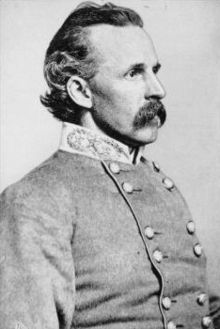Edward Lloyd Thomas
Edward Lloyd Thomas | |
|---|---|
 Edward L. Thomas | |
| Born | March 23, 1825 Clarke County, Georgia |
| Died | March 8, 1898 (aged 72) McAlester, Oklahoma |
| Place of burial | |
| Allegiance | |
| Service | |
| Years of service | 1847–48 (USA) 1861–65 (CSA) |
| Rank | File:Confederate States of America General.png Brigadier General |
| Commands | Thomas's Brigade, ANV |
| Battles / wars | Mexican-American War American Civil War |
| Other work | planter, Land Bureau, Indian Bureau agent |
Edward Lloyd Thomas (March 23, 1825 – March 8, 1898) was a Confederate brigadier general of infantry during the American Civil War from the state of Georgia. He was colonel of the 35th Georgia Infantry Regiment, which was assigned to Joseph R. Anderson's brigade, which became part of A.P. Hill's famed "Light Division." When Anderson left to take control of the Tredegar Iron Works in Richmond, Thomas was promoted to brigadier general to command the brigade. He retained this position for the rest of the war and was present at all of the major battles of the Army of Northern Virginia
Thomas was a graduate of Oxford College of Emory University and served in the Mexican-American War. He was an uncle to famed American Old West lawman Heck Thomas who helped bring down the Doolin Dalton Gang.
Early life
Thomas was born in Clarke County, Georgia, to Edward Lloyd Thomas (surveyor) and Mary Hogue, the youngest of eleven children. He was a graduate of Oxford College of Emory University and served in the Mexican-American War from May 1847 until August 1848 as a second lieutenant in an independent company of Georgia mounted men. Before serving he farmed in Whitfield County, Georgia. Three of his brothers were Confederate officers: Henry Philip (b. 1810) a colonel in the 16th Regiment of Georgia was killed in battle at Fort Sanders in Knoxville, Tennessee, in 1863; Lovick Pierce Thomas, I (1812–1878) captain and quartermaster of the 35th Georgia Infantry resigned in 1863 due to injury; Wesley Wailes (1820–1906) served as a major in Phillip's Legion of Cavalry.
Civil War
In October 1861, Thomas became colonel of the 35th Georgia Infantry. The regiment was attached to Brig. Gen Joseph R. Anderson's brigade, which was initially stationed in Georgia, but during the Peninsula Campaign was sent to the Richmond area to reinforce Joe Johnston's army. On May 27, 1862, the brigade was added to the newly created division of Maj. Gen A.P. Hill, soon to be known as the "Light Division". While commanding the regiment, Thomas suffered a minor wound at the Battle of Beaver Dam Creek (Mechanicsville) during the Seven Days Battles. Anderson was wounded at Glendale and afterwards resigned his commission to manage the Tredegar Iron Works in Richmond. Thomas then became permanent commander of the brigade and on November 1, he was promoted to brigadier general, participating in all of the major battles and campaigns fought by the Army of Northern Virginia.
When division commander William D. Pender was mortally wounded at Gettysburg, the two ranking brigade commanders left in the division were Thomas and James H. Lane. Although both had been promoted to brigadier general the same day (November 1, 1862), Lane had received his colonel's commission in September 1861, a month before Thomas had become a colonel, and thus Lane outranked him and assumed temporary command of the division. It has been suggested that as a Georgian, Thomas was not favored in a division with two North Carolina brigades. He remained in command of his brigade until the surrender at Appomattox.
Postbellum career
After the war, Thomas returned to Georgia and farmed in Newton County near Covington. In 1885, President Grover Cleveland appointed him to a position as a Special Agent of the Land Bureau in Kansas. Later he was made Indian Agent at the Sac and Fox Agency, Indian Territory, Oklahoma. After being in poor health for some time, Thomas died on March 8, 1898 in South McAlester, Indian Territory, and is buried in Kiowa, Oklahoma.
See also
References
- Eicher, John H., and David J. Eicher, Civil War High Commands. Stanford: Stanford University Press, 2001. ISBN 978-0-8047-3641-1.
- Huff, Frederick Ware. Four Families: Winn, Thomas, Ware, Garrett of the Southern United States from 1600s to 1993. Kennesaw, GA: Frederick Ware Huff, 1993. OCLC 29382913.
- Sifakis, Stewart. Who Was Who in the Civil War. New York: Facts On File, 1988. ISBN 978-0-8160-1055-4.
- Warner, Ezra J. Generals in Gray: Lives of the Confederate Commanders. Baton Rouge: Louisiana State University Press, 1959. ISBN 978-0-8071-0823-9.
External links
- "Edward Lloyd Thomas". Civil War Confederate Brigadier General. Find a Grave. February 10, 1999. Retrieved August 15, 2010.
- Short biography of Edward L. Thomas
- 35th Georgia
- 16th Georgia Infantry
- Phillips' Legion
